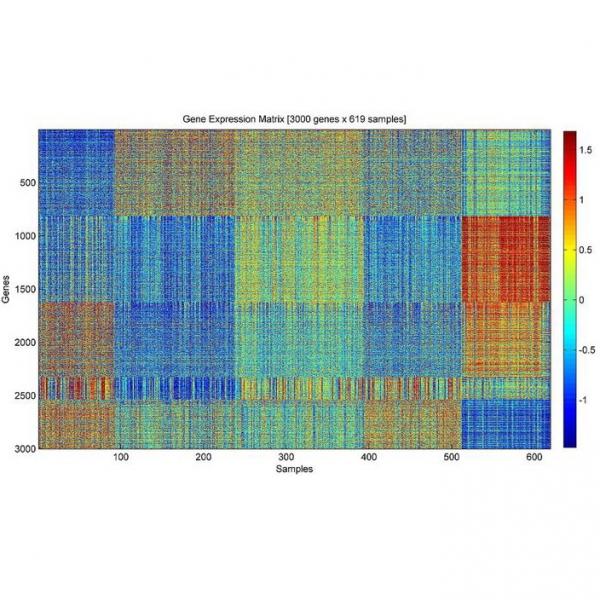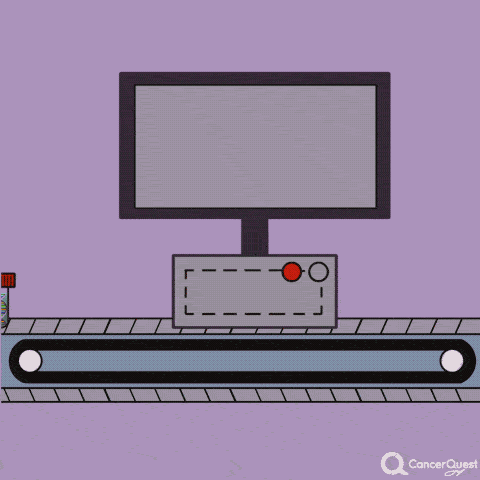
What are genes?
Genes are the unit of heredity in all living organisms. They are long strings of deoxyribonucleic acid (DNA). The collection of genes in a person acts as a blueprint for the entire body. Everything from your eye color to your height and even some personality traits can be coded for in your DNA. The collection of genes that an individual has is referred to as their genome. In humans, the genome is located on 46 chromosomes (other animals and plants have different numbers of chromosomes). Chromosomes in an individual are inherited - one set of 23 comes from the mother and the other set of 23 comes from the father. Just as a language is made up of letters and words, genes are made up of a set of 4 building blocks, called nucelotides. The chemical names for the four nucleotides in DNA are abbreviated as A, C, G, and T. Some genes contain the information that guides the production of proteins. In these genes the DNA “letters” are organized into three letter ‘words’. These triplets are precursors to the ‘codons’ found in messenger RNA. They guide the formation of proteins; each three-letter codon guides the insertion of a single amino acid.
Learn about transcription and translation.
Learn about cancer-related genes.
What are genetic mutations?
Damage to DNA can lead to changes in the encoded information. These changes are called mutations. Some mutations can cause diseases, including cancer. Genetic testing technology gives some people the option of finding out which mutations caused their cancer, or whether they have inherited a gene mutation that may cause cancer in the future. Genetic changes that are found in a peson's eggs or sperm can be passed down their children. These changes may to lead to cancer and many of them can be identified by genetic tests.If the human genome were a book, genetic testing would be like looking for typos. These typos can be caused by harmful environmental factors, such as chemicals in cigarette smoke or UV rays from the sun, or they can be inherited and passed down through families. Some mutations almost always cause cancer, while others can just increase the patient’s risk for particular cancers. It is important to remember that we all have the genes that are associated with cancer risk. For example, everyone has the BRCA1 gene. It is mutations in BRCA1 that can increase cancer risk. It is the mutations that genetic tests are designed to find.
There are different types of mutations that alter the DNA sequence of a gene. Mutations can vary in severity – some have no known effects and others can have large health effects.
Learn more about mutations and their effects.
What is genetic testing? Who is it for?
Genetic testing can be done before or after diagnosis. Predictive or preventative tests are sometimes recommended for those who have a family history of cancer, or have been exposed to a harmful agent that could put them at high risk, like cigarette smoke or UV radiation. Diagnostic tests are recommended for those who have just been diagnosed with a cancer that may be treated with targeted therapies or checkpoint inhibitor immunotherapies. The tests help the patient and physician decide which course of treatment will be most effective. Depending on the condition, tests can be performed on tumor samples, blood samples, or hair and skin samples. These samples are sent to a laboratory, where technicians look for abnormalities in chromosome structure, proteins, and/or DNA sequences.1

Cells from blood or other tissues can be examined to look for genetic changes (mutations) that could be linked to cancer. Testing can be done on patients without cancer or on cancer itself. The results can be used to determine possible prevention or treatment options.
Hereditary (familial) Cancers
Inherited cancers are usually caused by a mutation in a tumor suppressor gene. A tumor suppressor is a protein that regulates cell division and other related processes. Tumor suppressors are responsible for DNA damage repair, and to make sure that cells with damage do not continue dividing. When a person inherits a genetic mutation in any gene, the mutation is present in every cell in their body, since each cell is equipped with the same genetic code. However, in order for cancer to actually form, a second mutation must occur in a cell. This concept is known as the “Two Hit Hypothesis”. Those with an inherited genetic mutation already have one hit in every cell. These individuals are more susceptible to cancer because it is very likely that another mutation will occur in a cell at some time, causing that particular cell to have 2 hits, and potentially divide out of control.
Genetic testing can use used to detect mutations associated with several types of cancer, including some forms of breast cancer, colon cancer, eye cancer, kidney cancer, and endocrine cancers.
Learn more about hereditary cancers and their gene mutations.
Do genetic mutations occur throughout life?
The short answer is 'Yes'. Genetic mutations that occur randomly are known as spontaneous mutations. Spontaneous mutations can occur in tumor suppressor genes, and can also occur in proto-oncogenes. Proto-oncogenes drive cell division forward and are often transcription factors or growth factors, meaning they are responsible for telling a cell to start copying (replicating) its DNA. When a proto-oncogene gets mutated and becomes abnormal, it is referred to as an oncogene. A big difference between oncogenes and tumor suppressors is that mutations in oncogenes are usually ‘dominant’, meaning only one copy of the gene needs to be defective to cause damage. Mutations in oncogenes are rarely inherited because they often result in embryonic lethality. However, two known exceptions to this are oncogenes RET and CDK4. Both RET and CDK4 encode for protein kinases. RET is implicated in familial thyroid carcinomas, and CDK4 is implicated in familial melanoma.2 On the otherhand, mutations in tumor suppressors are typically recessive, meaning that in most cases, both copies must be defective to cause damage (note that humans have two copies of most of their genes - one copy from each parent).
There are many different oncogenes, and it is safe to say that at least one oncogene will be active in any given case of cancer. Genetic testing for specific oncogenic mutations can be very important for designing treatment plans. By finding out the mutation(s) that caused the cancer, physicians are better able to determine a patient's course of treatment, such as whether or not to use immunotherapies, targeted therapies, or chemotherapies. Immunotherapies work by boosting a patient's immune system, so that it is better able to kill cancer cells. Current targets of immunotherapies are CTLA-4 and PD-1 receptors. 3Examples of immunotherapies include: Yervoy® (ipilimumab), Opdivo® (nivolumab), and Keytruda® (pembrolizumab). Targeted therapies work by binding specific oncoproteins. For example, the drug Herceptin® (trastuzumab) targets the HER2/neu oncogene product present in some breast cancers. Bcr/Abl, a mutant protein that drives chronic myeloid leukemia, is blocked by the drug Gleevec® (imatinib) and other drugs. Tarceva® (erlotinib) and Gilotrif® (afatinib) target EGFR, a cell surface receptor protein that is mutated in some patients with non-small cell lung cancer (NSCLC). Other cancers caused by mutations for which there are tests include acute lymphocytic leukemia, gastrointestinal stromal tumors (GIST), non-Hodgkin lymphoma, and melanoma.
Learn more about hereditary cancers.
Learn more about tumor suppressors.
- 1 How is genetic testing done? Genetics Home Reference. U.S. National Library of Medicine. [https://ghr.nlm.nih.gov/primer/testing/procedure]
- 2 Hodgson S. Mechanisms of inherited cancer susceptibility. J Zhejiang Univ Sci B. 2008 Jan;9(1):1-4. doi: 10.1631/jzus.B073001. [PUBMED]
- 3 Immunotherapy. National Cancer Institute. National Institutes of Health. [http://www.cancer.gov/about-cancer/treatment/types/immunotherapy]
